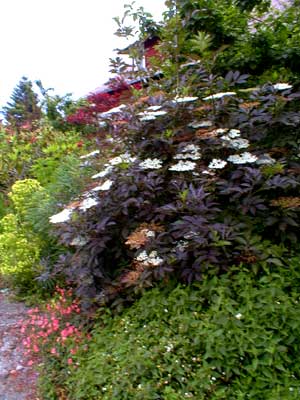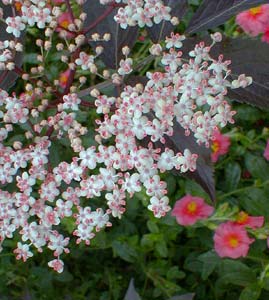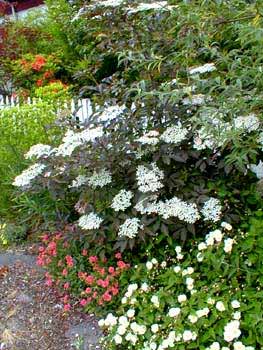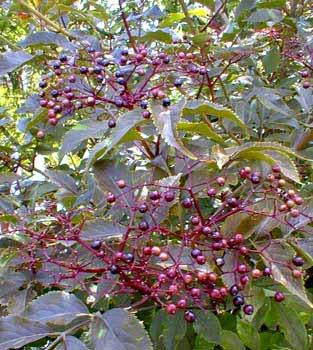
Is Sambucus nigra 'Purpurea'
doomed in the nursery trade?
"See the Kitten on the wall,
Sporting with the leaves that fall,
Withered leaves, one. two, & three,
From the lofty elder-tree!"
-William Wordsworth
(1770-1850)
(1770-1850)
 In 2002, a cabal of leading growers in the Netherlands, England, Canada & USA promoted a new European Elderberry cultivar called "Black Beauty 'Gerda'" as the ultimate purple-leafed cultivar.
In 2002, a cabal of leading growers in the Netherlands, England, Canada & USA promoted a new European Elderberry cultivar called "Black Beauty 'Gerda'" as the ultimate purple-leafed cultivar.The old standard 'Purpurea,' & a more recent one which was kind of a fake improvement over 'Purpurea' which is called 'Guincha Purple' (some nurseries have sold 'Purpurea' under the name 'Guincha Purple' completely randomly, as exact synonyms), according to the aforementioned cabal, would in a short time become extinct in the nursery trade.
'Black Beauty' was said to be so very much better that no other purple-leafed cultivar of the European elder would ever again be chosen by anyone who had a choice.
The big "2002 launch" of 'Black Beauty' could not meet the demand. Shortages of the well-promoted cultivar increased eagerness for the next year's plants. Pre-orders indicated this would indeed be the bestselling elderberry of all time. By 2004 sufficient stocks were in production that price came down, & that same year some of the smaller local nurseries which were already disinclined to carry multiple but similar cultivars discontinued 'Purpurea' from their stocks.
 The claim that other cultivars were doomed to extinction in the trade sounded to me like ninety percent hype. Elderberries require a second cultivar as companion in order to set the best fruit, & one could not do better than both 'Purpurea' & 'Black Beauty' as cross-pollinators. Yet to my surprise, in 2005 when I was looking for both of these shrubs to plant near one another on a property where I was doing some landscaping, every nursery in the vincity carried only 'Black Beauty' & no other S. nigra cultivar by any other name.
The claim that other cultivars were doomed to extinction in the trade sounded to me like ninety percent hype. Elderberries require a second cultivar as companion in order to set the best fruit, & one could not do better than both 'Purpurea' & 'Black Beauty' as cross-pollinators. Yet to my surprise, in 2005 when I was looking for both of these shrubs to plant near one another on a property where I was doing some landscaping, every nursery in the vincity carried only 'Black Beauty' & no other S. nigra cultivar by any other name.So what if the advertised threat or promise is coming true? If anyone wanted 'Purpurea' in their yard, will they now & in the future have to get cuttings from an old specimen in someone's garden? Will nurseries no longer have them? Elderberries grow very quickly, & it took the growers who decided to chuck all the 'Purpurea' to increase production stocks of 'Black Beauty' only two years to no longer have any 'Purpurea' to offer.
By 2008/9 a couple variations on 'Black Beauty' had been added as look-alike competition, & it had been a couple years since a regular ol' 'Purpurea' was available locally; even the discount production outfits who tend to pick up older varieties on the cheap were sticking with 'Black Beauty.'
 Purpurea is a beautiful shrub. Its leaves first emerge as deepest magenta in early to mid March, along with teency clusters of pink flower buds.
Purpurea is a beautiful shrub. Its leaves first emerge as deepest magenta in early to mid March, along with teency clusters of pink flower buds.The leaves quickly mature to a shiny purple-black for most of spring (the whole of spring if they get a bit of shade) while the pink buds develop into white flowers. Come warmer weather, the leaves turn purple-hued olive green. This is supposed to be a "fault" in that the purple doesn't last through summer, whereas 'Black Beauty's' leaves do stay purple until autumn colors supplant the purply-black.
I've always thought it was a plus that 'Purpurea' is purple-black in spring, olive-green in summer, then autumn red, then naked-branched. It seriously marks the seasons!
Our 'Purpurea' did not set fruit its first couple years because it had no second cultivar with which to cross-pollinate, so as soon as the prices of 'Black Beauty' came down, I added one to the array of shrubs & trees, & was happy to have them both. With the nearby companion in place, 'Purpurea' produced oodles of berries by summer 2004, as shown in the July portrait with fruits in various stages of ripeness.
If I'd only had room for one elderberry, I sure wouldn't want to be rid of 'Purpurea.' It has been growing some while near a purple Japanese maple, & is great fun to see the elder first match the maple in color, then contrast to the maple, then match it again in autumn when both turn red.
My initial sentiment was to dismiss the threat of 'Purpurea' becoming "extinct" in the trade has by now proven me wrong. I'm sure there'll always be a few specialty growers from whom it will be available always, but for mass production there was one factortoo much in favor of 'Black Beauty.' It has a lovely citrusy odor to the flowers. Other European elderberry cultivars have scentless flowers, while the blossoms of the American elderberry can sometimes smell putrid.
So even people who aren't fooled into believing it's "bad" that 'Purpurea' is purple-black only in spring or that 'Black Beauty's' better because it stays purple longest, well, the added promise of nice-smelling flowers only on 'Black Beauty' would make it the obvious choice if both cultivars were offered side by side & there was no room to have both. And that makes it comprehensible, but weird to think, that the long-standard 'Purpurea' has so swiftly become one of those heirloom shrubs available mainly if you get a start from someone who has an old one in their yard.
The photos on this page are of 'Purpurea' only. The first picture atop the page was snapped in May, showing at its foot a bright pink 'Mrs. Mold' sunrose & a White rock rose The second photo is from May a year earlier, taken pointing the camera straight down over one of the lowermost flowers, so that a couple blossoms of the 'Mrs. Mold' sunrose underneath the elderberry can again be seen. The fourth photo is of the fruits that are green in June, ripening to burgundy then black in July & August.
More 'Purpurea' photos from June & May respectively
can be seen on the page about
The Mythology of Black Elderberry.
& on the
'Purpurea' page of the Berries Gallery
& see also this page for more on
Sambucus nigra "Black Beauty 'Gerda'"
can be seen on the page about
The Mythology of Black Elderberry.
& on the
'Purpurea' page of the Berries Gallery
& see also this page for more on
Sambucus nigra "Black Beauty 'Gerda'"